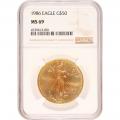Certified 1 oz Gold Eagles

The American Gold Eagle is the renown gold coin in the US and is annually produced in four size increments: 1 oz, 1/2 oz, 1/4 oz, and 1/10 oz. When the Gold Bullion Act of 1985 was passed, the legislation demanded that there would be four weight sizes offered and two different types of coins minted. There were two conditions minted, brilliant uncirculated and proof (although the proof condition was only offered in 1 oz increments at first). The legislation also specified that the precious metals used, in the making of the American Gold Eagle, would be mined within the US.
The Certified 1 oz American Gold Eagles are coins that have undergone an authentication process by a reputable grading agency. During this process, coins are inspected using advanced technology to determine its appearance quality. A coin is then assigned a grade ranging from 1-70 (MS65 for example), and is placed in a "slabbed" holder for protection. This holder verifies the coin's condition and where the coin was graded.
Design History of the American Gold Eagle
Augustus Saint-Gaudens was an American Sculptor, who specialized in the ideals of the American Renaissance. His design, of the $20 Saint-Gaudens gold coin, was the inspirational design of the American Gold Eagle. Although some aspects of the original design have been updated, such as the number of stars that hug the edge of the rim, the American Gold Eagle is a modern homage to the classic. Miley Busiek, also an American sculptor, honored Saint-Gaudens' timeless design while recreating something original as well.
The obverse design features a fierce Lady Liberty carrying an olive branch in one hand and an ignited torch in the other. The olive branch represents the country's desire for ultimate peace. The torch is the symbol of enlightenment and has been used, in the United States, as a means to freedom and liberty; enlightenment births freedom. Lady Liberty is stressed in a loose and flowing robe, marching with the US Capital building behind her. Next to her is the coin's date of mintage; from 1986-1991, the coin's date was cast in Roman Numerals, instead of the familiar Arabic Numeral System. Along the rim are 50 stars, each representing a US state, a design that has been used on other emblematic US coins, such as the Morgan Silver Dollar. The original design featured only 46 stars, since that was how many states existed from 1907-1933.
The reverse displays the emblem of the nation, hand-picked by the Founding Fathers. The bald eagle is the king of the birds of prey and represents fierce beauty, strength, and independence. There are 3 bald eagles represented on the reverse design of the American Gold Eagle. The eagles have made a nest of olive branches and have started reproducing, with an infantile eagle represented under its mother. The coin's weight, purity, and monetary value are written underneath the eagle family.
Certified 1oz American Gold Eagles
One of the most common questions we are asked is: what is the difference between Certified and Non-Certified coins. The most obvious difference is how the coin is packaged. Non-Certified coins usually do not come in any packaging or they come in their originally issued packaging, such as the Proof Gold Eagles come in their presentation boxes. Certified coins are placed in airtight, official holders, marked by the grade they received and the name of the certifying grading agency. Since Certified coins' condition is more specified than a Non-Certified coin, their value can greatly increase. Collectors and numismatists appreciate Certified coins since most of the work is done for them and they can just reap the benefits of owning a Certified coin.
There are many coin grading agencies out there but only two that are revered worldwide. The Numismatic Guaranty Corporation (NGC) and the Professional Coin Grading Service (PCGS) are two companies that issue coins their grades. These companies not only certify coins, but they also encase the graded coin into an official holder, preserving the coin and marking the holder with its earned grade. This alone has changed the coin collecting game, while also offering a peace of mind for collectors and investors.
Learning about the Sheldon Numeric Scale isn't necessarily a priority for investors but can deem useful when looking to purchase Certified 1 oz American Gold Eagles. Dr. William Sheldon was an American psychologist by trade and a numismatist as a hobby. In 1948, Sheldon developed the Sheldon Numeric Scale, which became the foundation of grading and certifying coins. The Sheldon Numeric Scale dictates that a coin's condition can fall between 1 and 70. Before this groundbreaking system, coins were graded mostly by physical appearance and could receive one of three grades.
When purchasing a Certified 1 oz American Gold Eagle, there is information provided on the coin holder that is important to know. The first thing to notice is the coin's strike type:
- MS: Short for "Mint-State;" refers to coins that have never been in circulation and are the same condition as when they were originally produced. Mint State coins will receive a grade ranging from 60-70 on the Sheldon Numeric Scale.
- PF/PR: Abbreviation for "Proof;" refers to the method of coin manufacture, made for eye appeal among collectors.
- SP: A "specimen" coin is a combination of strike type (somewhere in the middle of Mint State and Proof).
A Certified American Gold Eagle (or any certified bullion coin) will most likely come in one of two grades:
- MS/PF70: Bullion coins that have kept their original mint luster and contain zero post production flaws.
- MS/PF69: Bullion coins that contain 2 or less minute imperfections but still carry their original mint luster.
Other certification terms often used for bullion coins:
- First Strike: PCGS term designates coins that have been certified within the first 30 days of production by the contributing mint.
- Early Release: NGC term designates coins that have been certified within the first 30 days of production by the contributing mint.
- UCAM/DCAM: Shortened for Ultra-Cameo and Deep-Cameo, these terms refer to the coin's visual brilliance that is apparent on the surface by an unyielding, frosted finish and a deeply mirrored background luster.
History of the American Gold Eagle Production
The American Gold Eagle is considered to be 22-karats, instead of the ideal 24-karats. The 22-karat alloy is also referred to as "crown gold" since this was the English standard of metal content and hasn't been used since 1834. The American Gold Eagle actually contains one solid ounce of .999 pure gold, and it also weighs more than one ounce, due to the silver and copper added. This alloy of metals results in a wear-resistant coin, allowing for it to uphold over time. Both the weight and gold purity are authorized by the US Mint and are recognized, by the US Congress, as true gold bullion coins.



